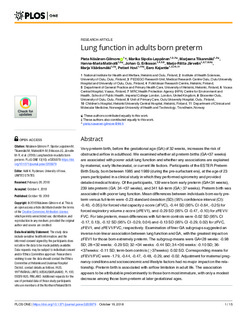| dc.description.abstract | Very preterm birth, before the gestational age (GA) of 32 weeks, increases the risk of obstructed airflow in adulthood. We examined whether all preterm births (GA<37 weeks) are associated with poorer adult lung function and whether any associations are explained by maternal, early life/neonatal, or current life factors. Participants of the ESTER Preterm Birth Study, born between 1985 and 1989 (during the pre-surfactant era), at the age of 23 years participated in a clinical study in which they performed spirometry and provided detailed medical history. Of the participants, 139 were born early preterm (GA<34 weeks), 239 late preterm (GA: 34-<37 weeks), and 341 full-term (GA≥37 weeks). Preterm birth was associated with poorer lung function. Mean differences between individuals born early preterm versus full-term were -0.23 standard deviation (SD) (95% confidence interval (CI): -0.40, -0.05)) for forced vital capacity z-score (zFVC), -0.44 SD (95% CI -0.64, -0.25) for forced expiratory volume z-score (zFEV1), and -0.29 SD (95% CI -0.47, -0.10) for zFEV1/FVC. For late preterm, mean differences with full-term controls were -0.02 SD (95% CI -0.17, 0.13), -0.12 SD (95% CI -0.29, 0.04) and -0.13 SD (95% CI -0.29, 0.02) for zFVC, zFEV1, and zFEV1/FVC, respectively. Examination of finer GA subgroups suggested an inverse non-linear association between lung function and GA, with the greatest impact on zFEV1 for those born extremely preterm. The subgroup means were GA<28 weeks: -0.98 SD; 28-<32 weeks: -0.29 SD; 32-<34 weeks: -0.44 SD; 34-<36 weeks: -0.10 SD; 36-<37weeks: -0.11 SD; term-born controls (≥37weeks): 0.02 SD. Corresponding means for zFEV1/FVC were -1.79, -0.44, -0.47, -0.48, -0.29, and -0.02. Adjustment for maternal pregnancy conditions and socioeconomic and lifestyle factors had no major impact on the relationship. Preterm birth is associated with airflow limitation in adult life. The association appears to be attributable predominantly to those born most immature, with only a modest decrease among those born preterm at later gestational ages. | nb_NO |

